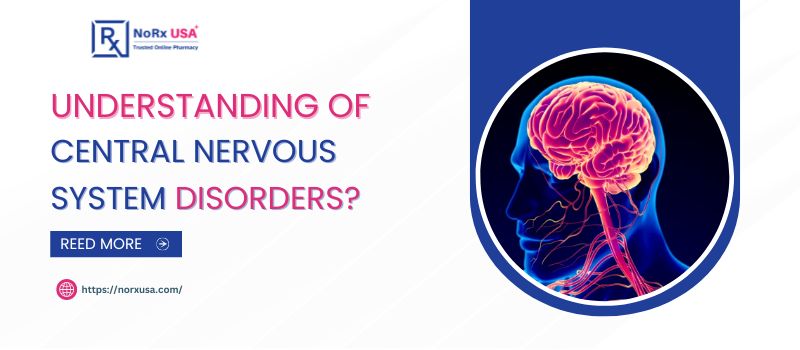
Understanding of Central Nervous System Disorders?
What is the focal sensory system (CNS)?
The brain and spinal cord make up the central nervous system, or CNS. The brain controls bodily functions, and the spinal cord connects the brain to peripheral nerves. The spinal canal is through which the spinal cord connects to the brainstem. The cerebrum is liable for developments, sensations, considerations, and so on. whereas certain reflex movements are controlled by the spinal cord without the brain’s interference.
Brain: It is an organ that serves as the center of the central nervous system and is in charge of every body movement. In vertebrates, it is the most significant and intricate organ. A human cerebrum comprises of a great many neurons that assistance to convey messages all through the body.
Nervous system: A long bundle of nerves and cells called the spinal cord runs from the upper back to the lower back. It is in charge of distributing signals throughout the body.
What is a disorder of the central nervous system?
Disorders of the central nervous system are neurological conditions that have an impact on the structure and function of the brain and spinal cord, also known as the central nervous system. The normal neurological issues incorporate Consideration shortage hyperactivity problems, mental imbalance, enslavement, seizures, catalepsy, and headaches.
CNS disorders include meningitis, locked-in syndrome, Tourette’s, a brain tumor, and myelopathy.
Various sorts of Focal sensory system Problems
Coming up next are various sorts of focal sensory system problems that influence the construction and working of the cerebrum and spinal rope.
Hyperactivity and attention deficit disorder: It is a neurodevelopmental and behavioral disorder that causes people to be impulsive and hyperactive. Concentration and following instructions are difficult for people with ADHD. The brain’s structural and chemical imbalances are the root cause of ADHD. One of the perilous neurological problems influences the exhibition of a person at school, school, or the work environment.
What is the best medication for ADHD?
Here is the best medication for ADHD, as effectiveness varies by individual. Common options include stimulants like Adderall and Ritalin, and non-stimulants like Strattera. Treatment choices depend on personal needs and medical advice.
Autism: It is a type of neurodevelopmental disorder that causes patterns of behavior that are restricted and repetitive. Social interaction and communication are difficult for people with this disorder.
Addiction: Compulsion is a mind reward framework jumble caused due to transcriptional and epigenetic systems.
Seizures: The most serious and fatal condition of the central nervous system, seizures are brought on by abnormal electrical activity in the brain. As per the nervous system specialist, Seizures result from hypersynchronous, over the top, and strange neuronal movement in the cerebrum.
Catalepsy: It is a type of CNS disorder that reduces pain sensitivity and causes muscular rigidity and immobility.
Migraine: It’s a neurological condition that makes headaches from mild to severe.
Meningitis: Meningitis causes aggravation and enlarging in the films of the mind and spinal lines. A few normal side effects of meningitis are fever, firm neck, heaving, bacterial or viral diseases.
Syndrome of confinement: The brainstem is damaged in locked-in syndrome. The facial muscles become paralyzed in locked-in syndrome, but consciousness remains.
Tumor in brain: Additionally, it is a dangerous disorder of the central nervous system that requires surgery to treat.
Tourette’s: One of the inherited disorders of the central nervous system, Tourette’s can present with the signs and symptoms of ADHD and obsessive-compulsive disorder.
Myelopathy: Injury in the spinal lines is alluded to as myelopathy. Myelopathy, also known as an injury to the spinal cord, can be caused by trauma, congenital stenosis, or degenerative diseases. The above list of CNS disorders is not all-inclusive.
The signs, symptoms, and causes of disorders of the central nervous system Every disorder of the central nervous system has a unique set of signs and symptoms. However, some of the most common signs and symptoms of all CNS disorders are persistent headaches, body aches, difficulty concentrating, memory loss, tremors, and other symptoms. CNS disorders can also cause seizures, paralysis, slurred speech, and loss of coordination.
What causes focal sensory system problems is as yet an inquiry to respond to, yet a few normal reasons for focal sensory system problems are:
Trauma: Traumatic brain injury, also known as a spinal injury, can result in a wide range of disabilities. The disorder cannot be predicted until the traumatized brain or spinal cord section has been diagnosed.
Infection: There are many different kinds of infections that can directly harm your brain and spinal cord. Microorganism invasion can lead to infections.
Degeneration: It causes loss of spine capability.
Defects in the structure: Common structural defects that result in CNS disorders include hypospadias, congenital disabilities, and spinal Bifida. Heat issues, limb malformations, and facial anomalies may occur in individuals born with structural defects.
Tumors of the central nervous system: The term “tumor” best describes abnormal tissue growth. At first, growths can be noncancerous, however with the progressing time, they become dangerous, which can transform into disease.
autoimmune conditions: The immune system of an autoimmune disorder begins to attack healthy body tissues.
Strokes: A stroke occurs when the blood supply to the brain and nervous system is suddenly cut off. Stroke causes because of impeded veins or burst veins.
Related treatment Options range from behavioral therapies to complex surgeries for central nervous system disorders. A specialist generally starts the treatment of CNS issues utilizing medications and further changes the treatment cycle according to the circumstance.
Neuroradiology identifies the following as typical CNS conditions:
Interventional neuroradiology: A small, flexible tube is inserted into the brain’s blood vessels as part of this treatment. This treatment prevents strokes caused by problems with the blood vessels. It works well for stroke treatment.
Microsurgery: In microsurgery, tiny instruments and magnifying lens is utilized to work the mind.
Radiosurgery that is stereotactic: It treats a variety of disorders of the nervous system. Stereotactic radiosurgery can assist with getting a powerful X-beam of the little region of the body without harming the cerebrum’s tissues.
Drugs, deep brain stimulation, spinal cord stimulation, neurorehabilitation, and spinal surgeries are all common CNS treatments.
